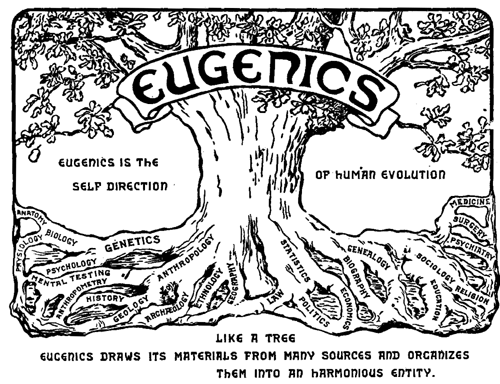We distinguish races in plants, animals, and humans. The term ‘race’ has had many different meanings and it has also been misused. Some have used it as synonym for ‘people’ or ‘ethnic group’. Hitler, in his book “Mein Kampf”, confused ‘race’ with ‘species’, when he wrote:
“The consequence of this nature-wide valid tendency to keep races pure is not only a sharp external distinction between individual races but also their homogenous nature within themselves. The fox is always a fox, the goose a goose, the tiger a tiger etc. … We will never find a fox with humane feeling towards geese, just like there will never be a cat with friendly feelings toward mice.” (translated by the author)
Clearly, Hitler did not know that ‘race’ is a sub-category of ‘species’.
Today, most anthropologists distinguish four major homo sapiens races: Mongoloid, Caucasoid, Negroid, and Australoid. There are typical race profiles, which depend largely on the characteristics chosen to define a race and there are gradual transitions from one typical major race profile to another. To avoid these fuzzy transitions, some anthropologists have differentiated those human groups that are in-between the major races into a large number of sub-races, which closely resemble ethnic units. For example, the Caucasoids or Europids are subdivided into Nordids, Lappids, Alpinids, Dinarids, Mediterranids, Orientalids, Berberids, Eastern Europids, Indides, Roma, Weddids, Armenids and Turanids. You see where this leads. Making up more races on the go. When a group does not quite fit into the larger race profile, it is proclaimed a subrace. Some human groups seem not to fall into any larger race group like the Lapps of Scandinavia or the Mbuti Pygmies of the Central African Ituri rain forest. And to define e.g. Jews as a race based on morphology would require some exquisite finagling.
Races have been defined in the past almost solely based on morphological markers such as skin color, head shape, nose shape, and hair type. Attempts have been made to define human race groups based on blood type or genetic markers, but it was found that there are virtually no genetic markers that coincide with the groups defined based on morphological markers. An individual placed morphologically in one race may end up in another one based on genetics.
Blood type A is more prevalent among Caucasoids, blood type zero is more frequent among Negroids, and type B is more frequent among Mongoloids, but there is more commonality of blood types between different races than within any specific race.
Recently, the concept of human races was considered scientifically unfounded as it was not confirmed by genetic evidence. None of the racial classifications, which strongly differ in the number of races and their composition, reflect actual genetic similarity and genealogy of human populations inferred from variability of classical markers and DNA regions. Moreover, variability between races was shown to be far lower than that within seemingly racially homogenous populations. Inter-racial variability was about 7 to 10% while intra-racial variability was up to 85% of the total genetic variation.
There are some oddities, like the Mongol spot and sickle cell anemia. 99% of the children of Chinese, Japanese, Koreans, Vietnamese, Mongols, Turk-peoples, Indonesians, Innuit Eskimos, and American Indians are born with a dark pigment spot on the lower back, which disappears later. The sickle cell disease is a genetically acquired (inherited) disease, which is widely prevalent among Negroids including African Americans. Approximately 73 out of 1,000 Black Americans (1 in 14), about 7 out of 1,000 Hispanic Americans and about 3 out of 1,000 white Americans are born with it.
In this age of political correctness, some anthropologists and biologists assert that races do not exist at all, just like some physicians, sociologists, and psychologists assert that there is no biological difference between men and women. But it is plain evident and obvious that humans occur in several typical variants, which are mainly defined by sets of morphological characteristics, such as skin color, physiognomy, shape of the cranium, the form of the nose, and the shape of the eyes, etc. It remains questionable, though, if morphological characteristics in humans are associated with or allow conclusions regarding behavioral traits, mental or intellectual capabilities or medical dispositions except for the few mentioned above.
There is general agreement that one single marker alone, such as skin color, cannot define a race. There must be a set of several markers and the more of them, the more clearly the race is defined. The set of characteristics that defines a race must be inheritable, i.e. genetically founded, since variable manifestations of the same physical feature (such as skin color or hair shape) reside in so-called alleles, defined as two or more variants of a gene that have the same relative position on homologous chromosomes and are responsible for alternative characteristics of the same morphological feature. Yet, attempts to define race genetically have generally failed.
Deeper investigation reveals two manifest facts:
- Differences in character, intellect, or moral integrity etc. do not follow the lines drawn by inherited morphological markers.
- These morphological markers are therefore just that – morphological markers – and nothing of significance can be concluded from them. Evilness, integrity, fortitude, weakness, intelligence, stupidity, honesty, and crookedness all occur in humans of all races – and are not easy to define.
De gustibus non est disputandum (you cannot argue about matters of taste) as the old Romans said. So, whether a paler or darker complexion is preferable is really not something we can seriously discuss. Likewise, a flatter, wider nose vs. a narrower more beak-like nose, or more curly hair or dark hair vs. straighter or more blondish hair. Or more slit-like eyes vs. rounder eyes. There might be individual preferences, but there sure is no objective preference.
The crux with the concept of race does not reside in distinguishing between human groups using different sets of morphological characteristics but in attaching value to the races thus defined. To attach value to difference, however, is probably as old as mankind itself. It roots in the universal human trend to consider one’s own group superior and all others inferior. The ancient Greeks, above all Aristoteles, were convinced that only the Greeks were “true” humans. For the Greeks, all other peoples were barbarians and of inferior character, capabilities, and culture. The Greek term “βάρβαροι” (plural), which goes back to the Sanskrit term “barbarāh”, means “stutterer”. The Greeks believed that only the Greek language was intelligible speak. All other languages were “stuttering” produced by uncivilized dimwits.
The main culprit, however, to propagate the false notion that morphological race characteristics imply emotional, moral, and intellectual characteristics, and that races must be valued differently, was the French Marquis Arthur de Gobineau, who, between 1852 and 1854, published the four volumes of his work titled “Essay about the inequality of the human races”. He postulated the idea that there is an ongoing battle between the races, some of which are ascending, while others are descending. He argued that ascending nations or races have different and superior capabilities as compared to descending races or nations and that mixing of the races will always lead to the demise of the superior race or nation.
It was also Gobineau who invented the idea that the “Arians” are a superior race. He borrowed the term from linguistics, where it made sense (the Indo-Arian language family) and transplanted it into race theory, where it made no sense. His teachings about race were spread in the German part of Europe by their translator, Karl Ludwig Schemann and by Richard Wagner’s wife, Cosima Wagner.
Key to evaluating and ranking races as more or less superior or inferior are culture and capability. Some races or nations did indeed develop highly sophisticated albeit mostly tyrannical cultures. Think of the Chinese, the Hindu Indians, the Egyptians, the empire of Alexander the Great, the Roman empire, the empires of the Inka and Azteca.
Strangely, race theorists seem unimpressed by the fact that these impressive so-called high cultures all started from very humble beginnings and finally all collapsed all the while being carried by the same race or nation. Says Adolf Hitler: But they declined when they mixed with other races and lost their purity.
Hitler’s assertion is quite obviously not supported by the historic facts. Races, ethnic groups and their cultures, have mostly become more vital, energetic, and creative after mixing with others and they tend to become sterile and stagnant if they are left to themselves for too long. Stagnation happened to the Chinese and Japanese when they tried to isolate themselves from contact with other races, nations, ethnic groups, or cultures. And nations or races that were still on a primitive and technically unsophisticated level were often elevated through – often unpleasant – acculturation with other cultures. At the time of the Roman Empire, e.g. when Tacitus wrote his book about the Germans (De origine et situ Germanorum, published in 98 after Christ), the Germans were a bunch of primitive wild tribes and were described by Tacitus much like the British described Africans in the 19th Century: uncivilized but natural. Those were the same Germans who 1900 years later proclaimed themselves to be Arian superhumans.
In 1775, Johann Friedrich Blumenbach wrote a doctoral thesis titled “De generis humani varietate nativa” (About the natural differences among humans). He came up with the term “Caucasian” for “the white race” claiming that the esthetically “most beautiful white people” live on the southern slopes of the Caucasus mountains in Georgia. However, the Caucasians he had in mind were mainly Indo-Europeans and looked less like Hitler’s Arians and more like today’s Armenians or Azerbaijanis. Obviously, beauty is in the eyes of the beholder. Blumenbach also argued that racial types cannot be sharply distinguished from each other and that they do not remain the same over time. He rejected the notion that there are superior and inferior races.
At the end of the 19th Century, anthropologists agreed mostly that there are four major human races and that they are defined mainly by morphological sets of characteristics, which were considered hereditary, and originally limited to certain geographical areas.
Toward the end of the 19th Century, Gobineau’s concept of “higher” and “lesser” races and of racial superiority of the Arians merged with the newly developed Eugenics movement, whose main early protagonists were Francis Galton and Houston Steward Chamberlain in England and Ernst Haeckel in Germany. In the early 20th Century, these theories contributed to the development of the “Ariosophy” movement and to the anthroposophical teachings and movement of Rudolf Steiner, whose mysticism and spongy thinking contributed much to the development of Hitler’s ideas about races and their superiority respectively inferiority.
When Eugenics appeared on the stage they interfered with the debate about race from the perspective of “improving” the entire human species. The term Eugenics was invented by Galton and is derived from the Greek “eugenes” meaning as much as “well born” or “good in stock”. Galton did not only aim at “improving” certain races. He wanted to improve mankind as a whole. Soon, Eugenics Societies began to form worldwide.

Initial projects to breed people of “high racial value” had already been undertaken in Germany and England around 1890 using selected partners for marriage. At the same time, Scandinavia and the USA enacted the first laws prohibiting procreation and forcing sterilization for “less valuable people”.
In 1904, the German biologist Alfred Ploetz founded the “Archive for Racial and Social Biology” and coined the term “racial hygiene”. His organization transitioned seamlessly into the Nazi “Bureau of Race Politics”.
The first International Eugenics Congress took place in London in 1912, suggesting that states adopt laws to sterilize the “unfit”. In 1921, the Second International Eugenics Congress put up a logo stating: “Eugenics is the self direction of human evolution”.
In the USA, Indiana was the first state to pass a sterilization law in 1907. Other states followed and by 1930, over 60,000 persons had been sterilized in the USA before these laws were overturned.
By the end of WWI, Eugenics organizations had been founded in the USA, Hungary, France, Italy, Argentina, Mexico and Czechoslovakia. The US Eugenics movement aimed at sterilizing the “feebleminded” and promoted “white Anglo-Saxons” as a superior race. The American Eugenics Society developed out of a committee of the Second International Eugenics Congress in 1926. One of its protagonists was Margaret Sanger, who promoted abortion as a means to eliminate the Negroid population of the USA. She founded “Planned Parenthood”.
Here some quotes from this ultra-racist lady:
“But for my view, I believe that there should be no more babies.”
Interview with John Parsons, 1947
“The most merciful thing that the large family does to one of its infant members is to kill it.”
Woman and the New Race, Chapter 5, “The Wickedness of Creating Large Families.” 1920
“We don’t want the word to go out that we want to exterminate the Negro population…”
Letter to Dr. Clarence J. Gamble, December 10, 1939, p. 2
“I accepted an invitation to talk to the women’s branch of the Ku Klux Klan… I was escorted to the platform, was introduced, and began to speak…In the end, through simple illustrations I believed I had accomplished my purpose. A dozen invitations to speak to similar groups were proffered.”
Margaret Sanger; An Autobiography, published in 1938, p. 366
“A marriage license shall in itself give husband and wife only the right to a common household and not the right to parenthood.”
Margaret Sanger, “America Needs a Code for Babies,” Article 3, 27 March 1934
“No woman shall have the legal right to bear a child, and no man shall have the right to become a father, without a permit for parenthood.”
Margaret Sanger, “America Needs a Code for Babies,” Article 4, March 27, 1934
“Organized charity itself is the symptom of a malignant social disease…”
Sanger, Margaret (1922). The Pivot of Civilization.
In 1933, Sanger’s magazine Birth Control Review published an article on “Eugenic Sterilization” by Ernst Rudin, chief architect of the Nazi sterilization program and mentor of Josef Mengele, the notorious Nazi doctor at Auschwitz. Hitler never quotes Margaret Sanger, but he was inspired by the writings of two of her associates, Leon Whitney of the American Eugenics Society and Madison Grant of the New York Zoological Society. During the 1930s, Whitney on one occasion visited Grant to proudly show him a letter he had just received from Hitler requesting a copy of Whitney’s book The Case for Sterilization.

Margaret Sanger
“Birth control is not contraception indiscriminately and thoughtfully practiced. It means the release and cultivation of the better racial elements in our society, and the gradual suppression, elimination and eventual extirpation of defective stocks – those human weeds, which threaten the blooming of the finest flowers of American civilization.”

Hillary Clinton
“I admire Margaret Sanger enormously, her courage, her tenacity, her vision. I am really in awe of her, there are a lot of lessons we can learn from her life.”
In 2009, Hillary Clinton accepted the Margaret Sanger Award.
These words give new meaning to Hillary’s words, when she referred to the rest of us as “a basket of deplorables”.
| Abortions in the USA, 1973 — 2020: | 63,600,000. (About the population of France in 2018) |
| Abortions in the USA, 2020: | 930,160. |
| Abortions by Planned Parenthood, 2020/21: | 383,460. |
According to the CDC, 38% of all abortions are non-Hispanic Black children. That would make for 353,461 black children aborted in 2020. African Americans currently made up approximately 12.4% of the US population in 2020. This means that African American babies are aborted at a 3 times higher rate than the share of African Americans in the US population.
I don’t know what you call this. I’d call it genocide.
So, what is the concept of ‘race’ good for? Nothing really, except for identifying groups of humans with similar morphological characteristics. If used in a value statement, ‘race’ lends itself excellently to all sorts of discrimination. Racism is not distinguishing and defining different races. They obviously exist. Racism is attaching value to them and to distinguish between more or less valuable races for social or political purposes.
Racism is also the midwife of Eugenics. And Eugenics are the megalomaniac belief that some humans are naturally and by necessity better than others and that the faulty human product provided by God or nature can and should be improved by mankind through abortion and genetic engineering.
Margaret Sanger is an icon of Planned Parenthood and of the Democratic Party and was a foremother of the Progressive Movement. She admired the Communist Soviet Union and was admired by Adolf Hitler and Hillary Clinton.
Are you a Democrat? If so, are you in good company?
